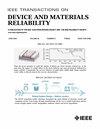A Gate-Level SER Estimation Tool With Event-Driven Dynamic Timing and SET Height Consideration
IF 2.5
3区 工程技术
Q2 ENGINEERING, ELECTRICAL & ELECTRONIC
IEEE Transactions on Device and Materials Reliability
Pub Date : 2024-11-27
DOI:10.1109/TDMR.2024.3508696
引用次数: 0
Abstract
Radiation-induced soft errors in Integrated Circuits (ICs) have always been a matter of great reliability concern. However, the ongoing shrinking of CMOS technology nodes, which results in high frequency, low power, and small area exacerbates the problem. Thus, accurate evaluation of the ICs’ vulnerability to such errors has become crucial, especially when a radiation-hardening process is developed. In this article, we present a gate-level Soft Error Rate (SER) estimation framework based on an event-driven approach that models the generated Single Event Transients (SETs) as event pairs that propagate through the circuit. Dynamic Timing Analysis (DTA) is performed to estimate SET arrival times at Flip-Flop (FF) inputs and detect a soft error. Moreover, our approach approximates the glitch height and considers the noise immunity thresholds of gates to evaluate potential SET electrical masking. Additionally, our event-driven framework enables accurate propagation of Single Event Multiple Transients (SEMTs), which have become commonplace in combinational circuits. Experimental evaluation on ISCAS ’89 benchmarks indicates that the proposed event-driven height-aware approach exhibits 21.06% more accurate SER estimation on average, compared to conventional graph-based techniques, with respect to SPICE simulation. F1 scores further strengthen the previous result, demonstrating an average improvement of 11.86%. In terms of failures in time, experimental results show that the graph-based approach overestimates SER by an average of 8558 and up to 16485 errors compared to the proposed method. Finally, our approach is used to effectively identify the most sensitive gates that could potentially be hardened in a SER mitigation scenario.具有事件驱动动态定时和SET高度考虑的门级SER估计工具
集成电路(ic)中的辐射软误差一直是一个值得关注的可靠性问题。然而,CMOS技术节点的不断缩小,导致高频,低功耗和小面积加剧了这个问题。因此,准确评估集成电路对此类错误的脆弱性变得至关重要,特别是在开发辐射硬化过程时。在本文中,我们提出了一个基于事件驱动方法的门级软错误率(SER)估计框架,该方法将生成的单事件瞬态(set)建模为通过电路传播的事件对。动态时序分析(DTA)用于估计触发器(FF)输入的SET到达时间并检测软错误。此外,我们的方法近似故障高度,并考虑门的噪声抗扰阈值来评估潜在的SET电掩蔽。此外,我们的事件驱动框架能够精确地传播单事件多瞬态(semt),这在组合电路中已经变得很常见。ISCAS ' 89基准的实验评估表明,与传统的基于图的技术相比,所提出的事件驱动高度感知方法在SPICE模拟方面的SER估计平均准确性提高了21.06%。F1成绩进一步巩固了之前的成绩,平均提高了11.86%。在时间失效方面,实验结果表明,与提出的方法相比,基于图的方法平均高估了8558个SER,高达16485个误差。最后,我们的方法用于有效地识别在SER缓解方案中可能被加固的最敏感的门。
本文章由计算机程序翻译,如有差异,请以英文原文为准。
求助全文
约1分钟内获得全文
求助全文
来源期刊

IEEE Transactions on Device and Materials Reliability
工程技术-工程:电子与电气
CiteScore
4.80
自引率
5.00%
发文量
71
审稿时长
6-12 weeks
期刊介绍:
The scope of the publication includes, but is not limited to Reliability of: Devices, Materials, Processes, Interfaces, Integrated Microsystems (including MEMS & Sensors), Transistors, Technology (CMOS, BiCMOS, etc.), Integrated Circuits (IC, SSI, MSI, LSI, ULSI, ELSI, etc.), Thin Film Transistor Applications. The measurement and understanding of the reliability of such entities at each phase, from the concept stage through research and development and into manufacturing scale-up, provides the overall database on the reliability of the devices, materials, processes, package and other necessities for the successful introduction of a product to market. This reliability database is the foundation for a quality product, which meets customer expectation. A product so developed has high reliability. High quality will be achieved because product weaknesses will have been found (root cause analysis) and designed out of the final product. This process of ever increasing reliability and quality will result in a superior product. In the end, reliability and quality are not one thing; but in a sense everything, which can be or has to be done to guarantee that the product successfully performs in the field under customer conditions. Our goal is to capture these advances. An additional objective is to focus cross fertilized communication in the state of the art of reliability of electronic materials and devices and provide fundamental understanding of basic phenomena that affect reliability. In addition, the publication is a forum for interdisciplinary studies on reliability. An overall goal is to provide leading edge/state of the art information, which is critically relevant to the creation of reliable products.
 求助内容:
求助内容: 应助结果提醒方式:
应助结果提醒方式:


